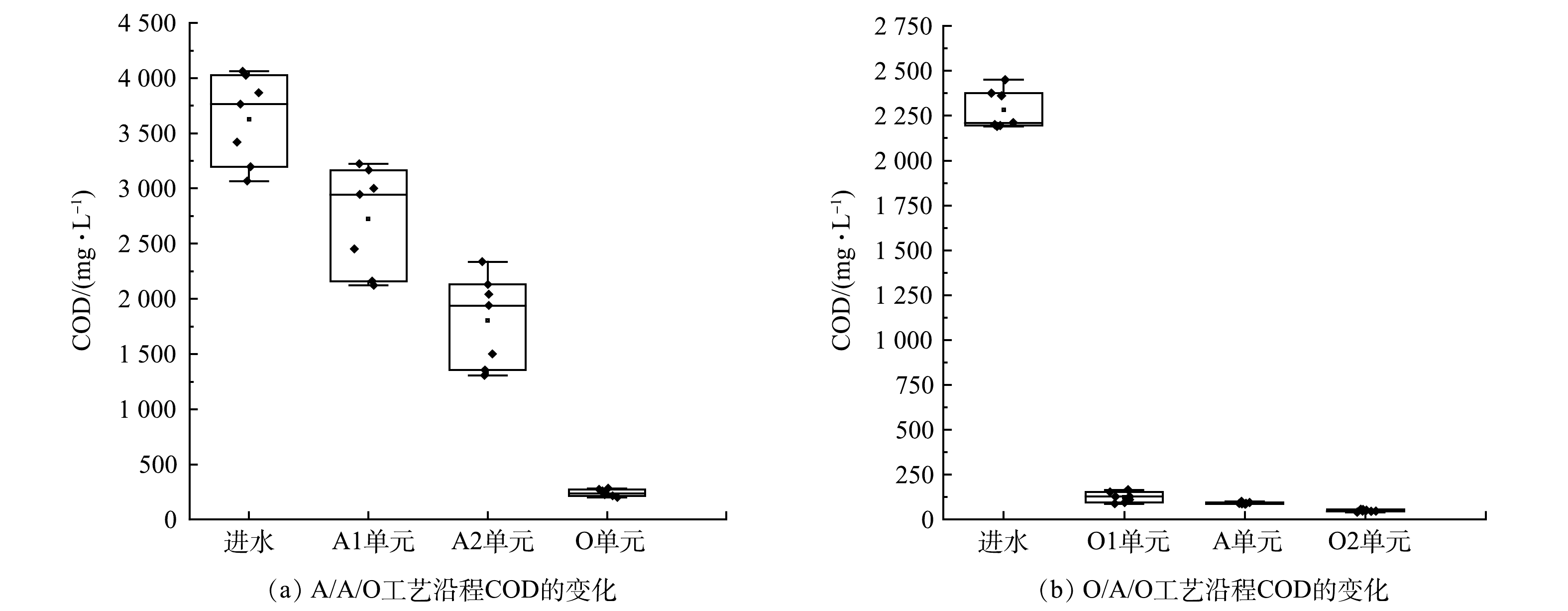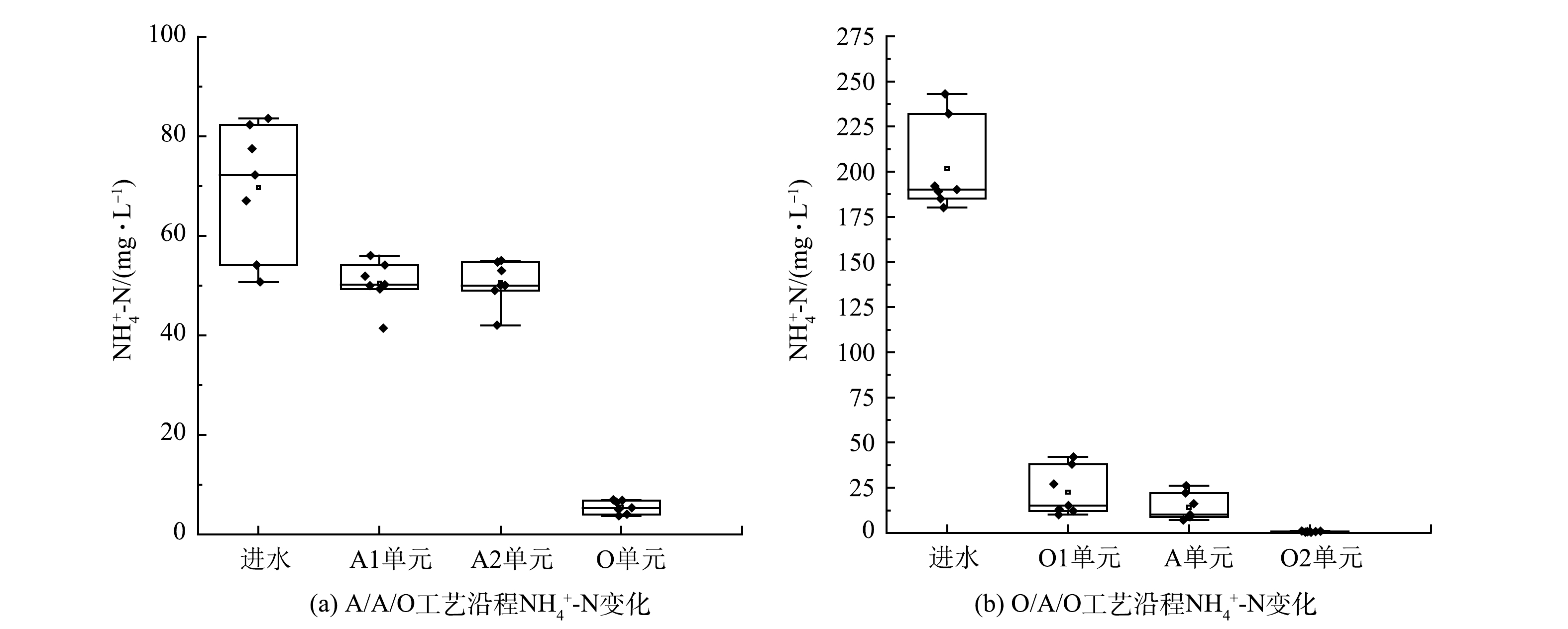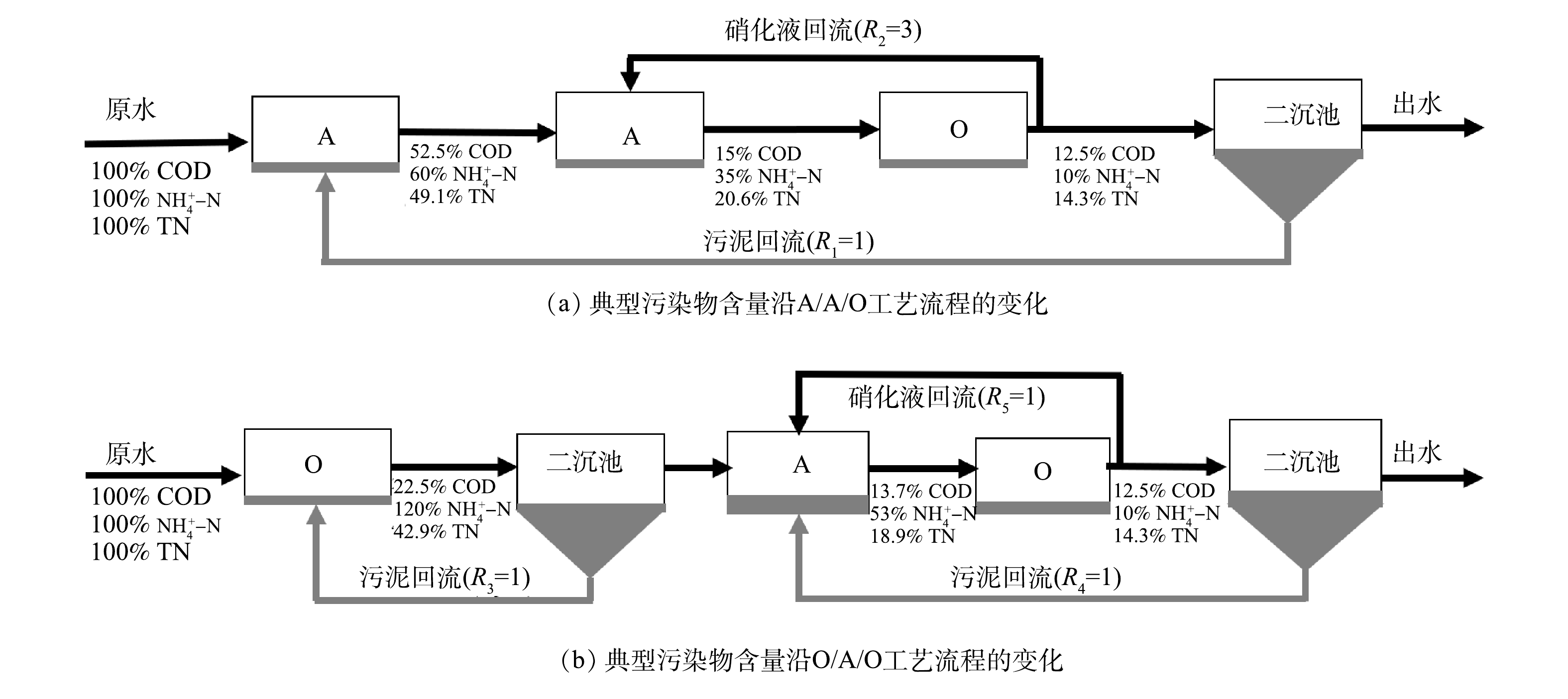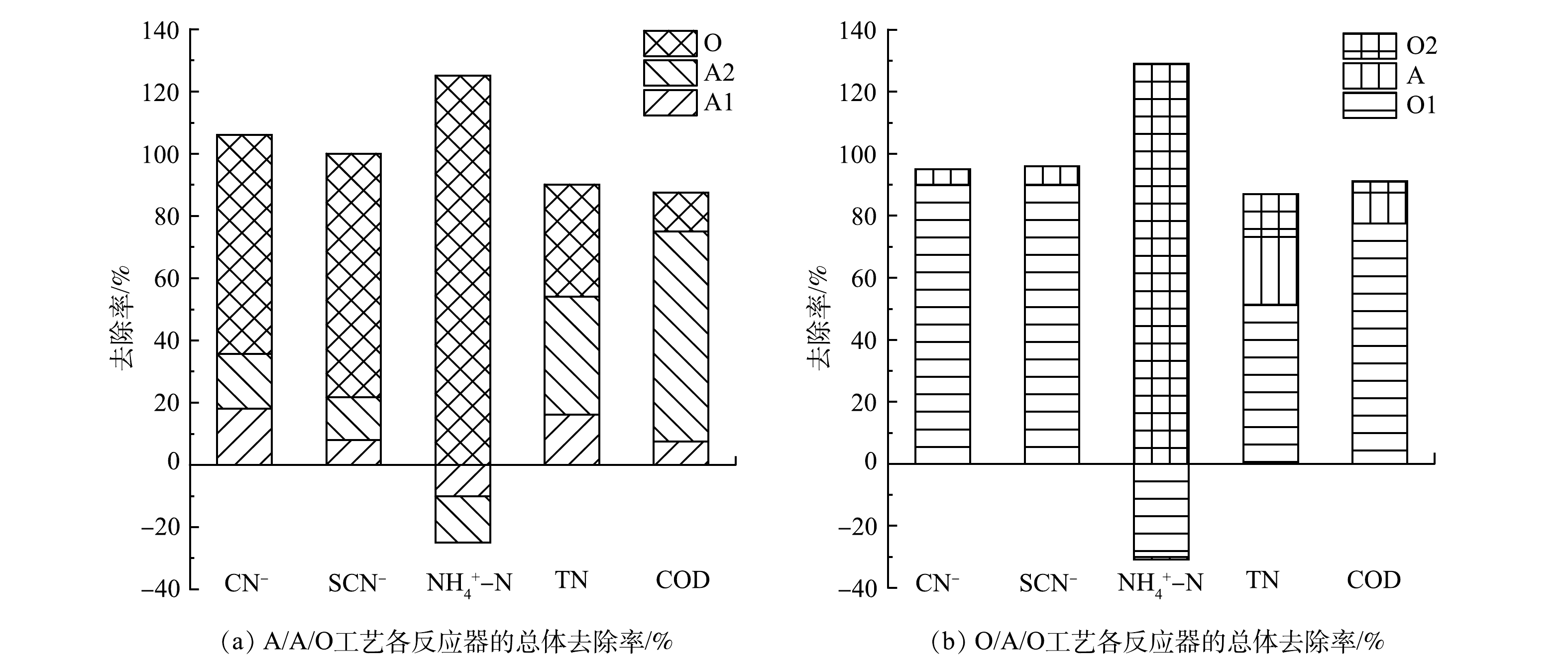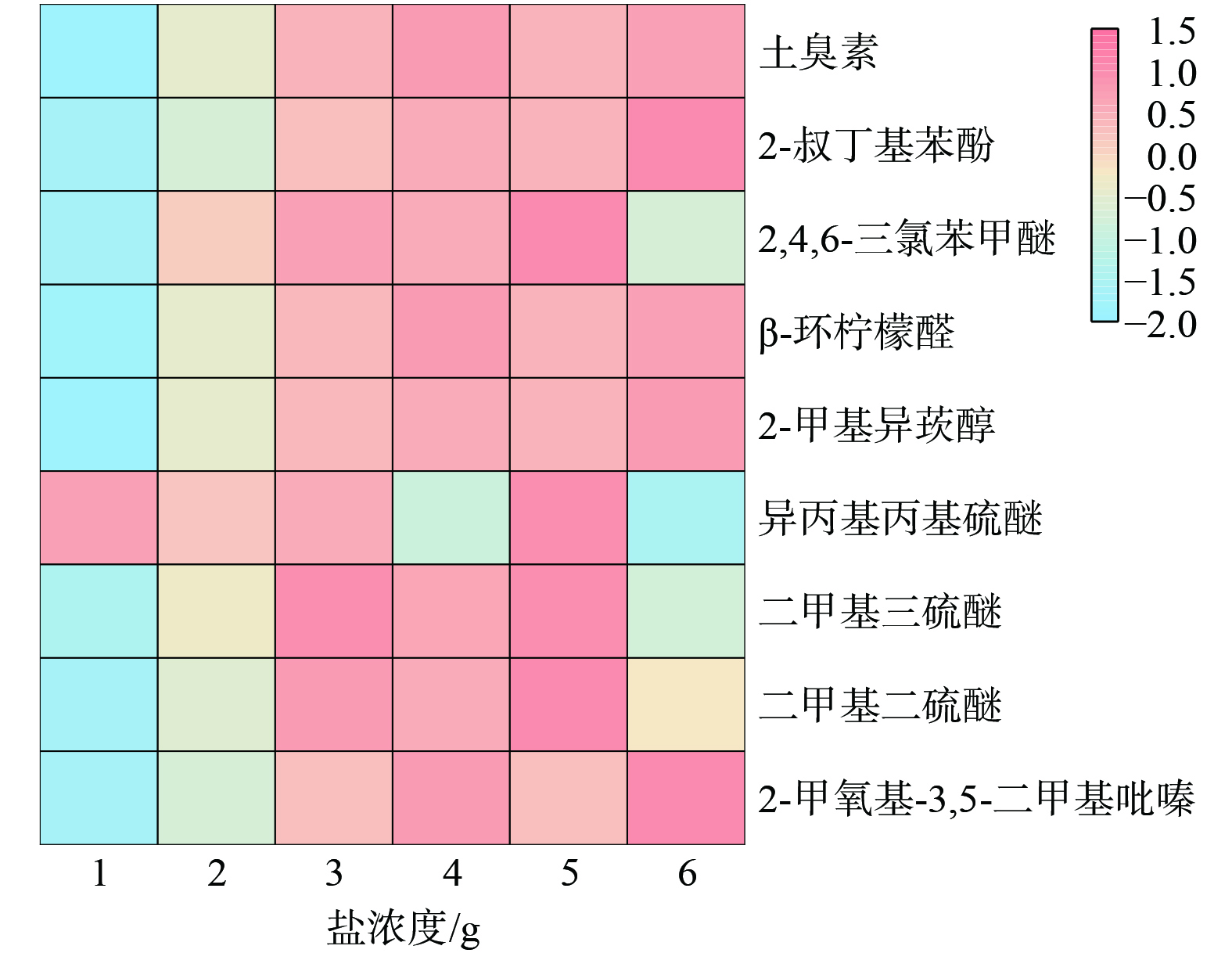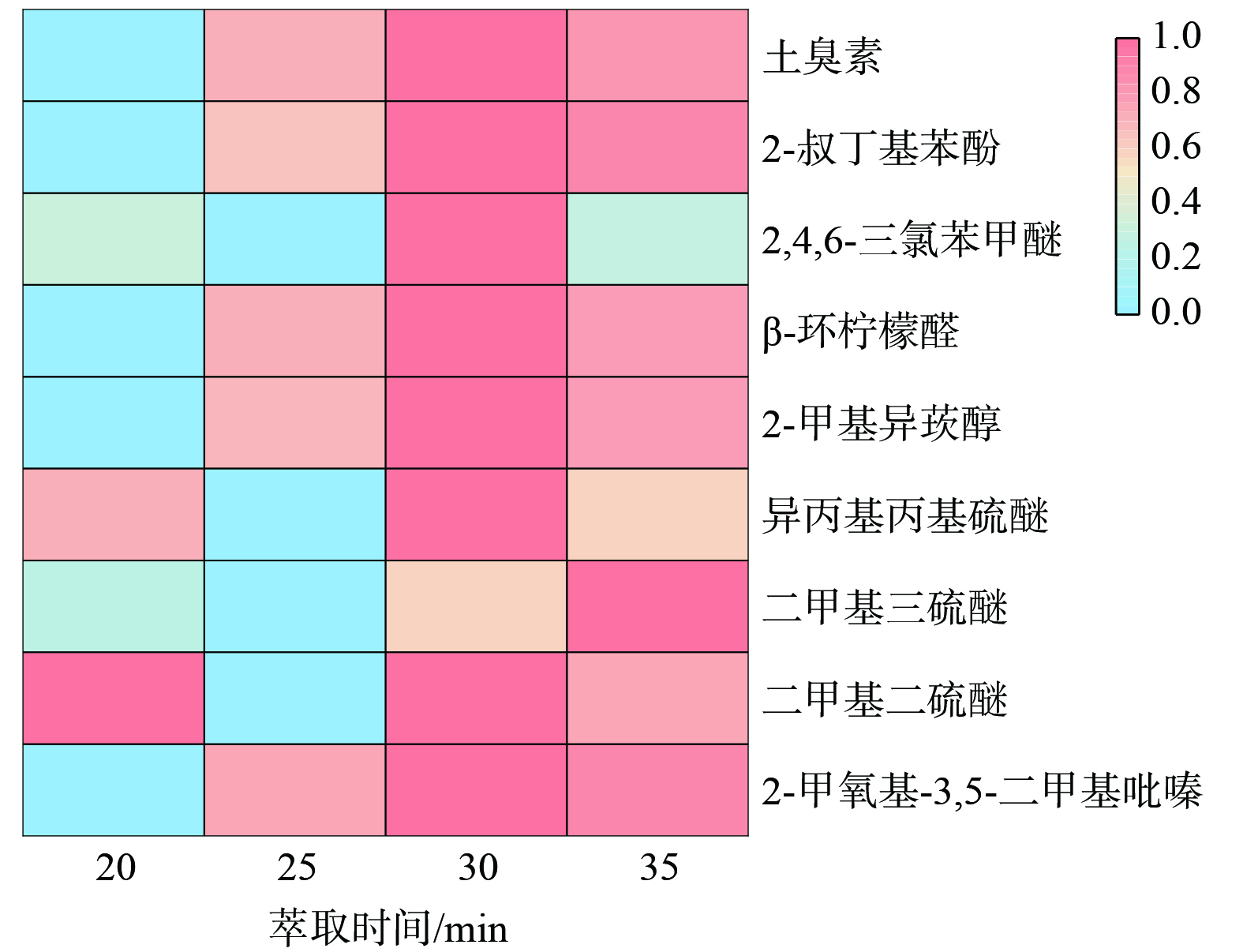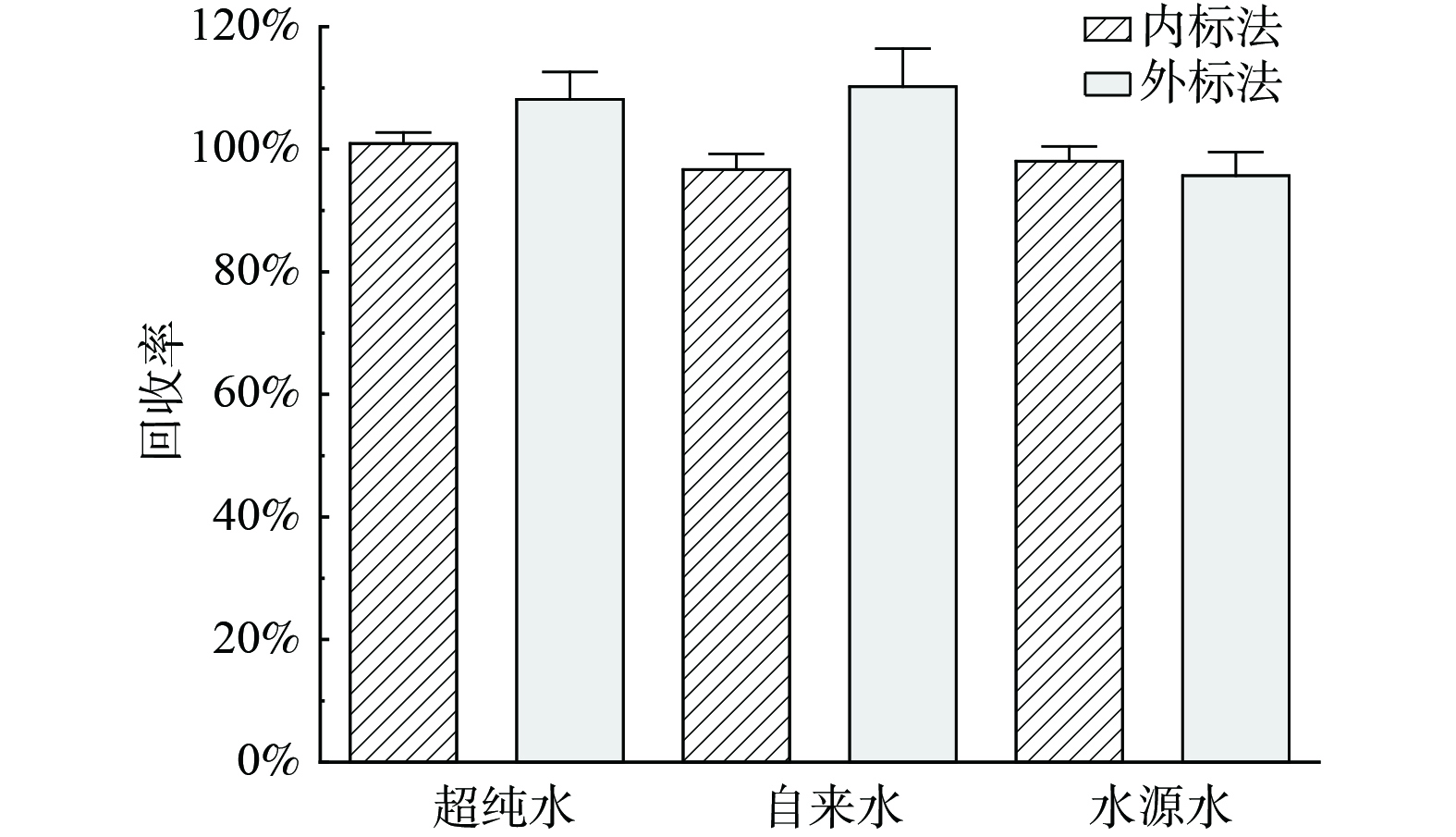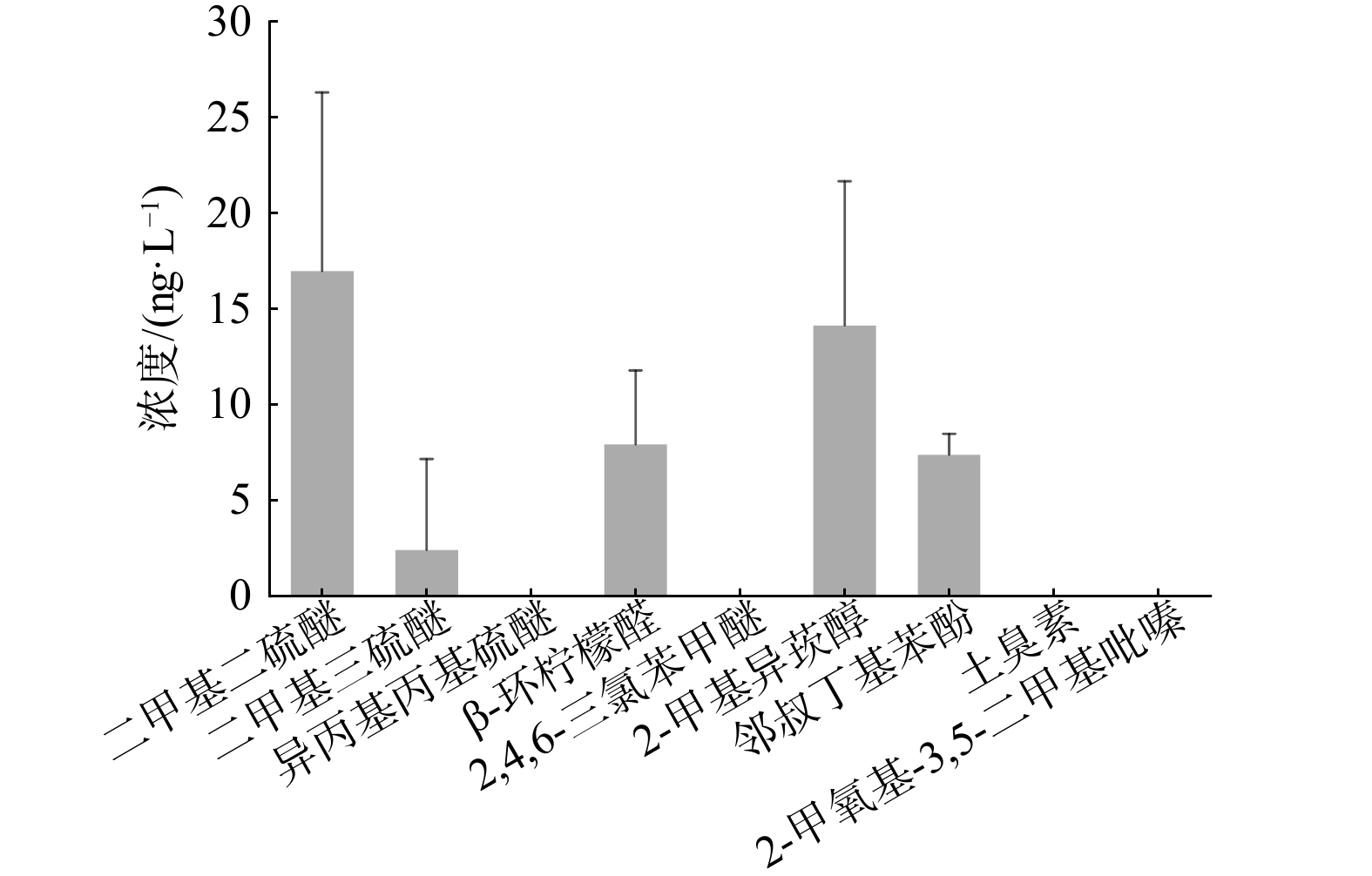-
饮用水嗅味是用户可以直接感受到的水质指标,关系到人民群众的获得感及对饮用水水质的信任度[1],随着用户对饮用水感官品质的要求升高,新版《生活饮用水卫生标准》 (GB 5749-2022) [2]更加关注了嗅味指标的重要性。一项针对我国55个重点城市自来水厂的水质调查结果显示,80%以上的水源及约40%的出厂水存在一定嗅味问题,主要的嗅味类型包括土霉味、腥臭味、化学品味和草木味等[3][4]。关键的致嗅物质涉及藻、微生物、工业等多种来源,具有不同物质结构与物理化学性质。除广泛报道的2-甲基异莰醇和土臭素等生物来源的土霉味物质,与污染有关的2-甲氧基-3,5-二甲基吡嗪也对土霉味产生贡献,该物质在极低的纳克/升水平即可导致嗅味问题[5-8]。二甲基二硫醚、二甲基三硫醚等硫醚类物质是水中腥臭味的主要来源,也是2007年太湖嗅味事件的主因[9]。藻类代谢物β-环柠檬醛可以导致水中草木味问题。工业化学品及副产物的排放可能导致水中化学品味、溶剂味、塑料味等问题,如2013年杭州饮用水源2-叔丁基苯酚污染导致饮用水塑料味问题[10]。考虑到饮用水中存在多种嗅味类型,开展不同嗅味类型的关键致嗅物质同时分析检测,是阐明我国饮用水嗅味污染特征并提出针对性管控措施的基础,对于进一步提升饮用水水质具有重要的意义。
目前,国内外针对典型土霉味物质2-甲基异莰醇和土臭素及腥臭味物质硫醚的检测方法已经有了较多报道,常采用气相色谱-质谱联用技术,并且已有了相应的标准检测方法。一些突发的致嗅新污染物如2-甲氧基-3,5-二甲基吡嗪、2-叔丁基苯酚等,检测方法鲜有报道,导致水厂应对能力不足。由于致嗅物质种类繁多、物理化学性质各异,但部分嗅阈值极低,可能存在多种低浓度嗅味物质协同致嗅,如何提升复杂样品中痕量致嗅物的分析准确度与精确度,是限制供水行业多种痕量致嗅物同时检测的关键。近年来发展的气相色谱-三重四极杆串联质谱法 (GC-MS/MS) 因其二级碎片的引入可以有效降低噪声干扰,提高分析的灵敏度。此外,在测试中,引入致嗅物的同位素标记物、或结构性质类似物作为内标,将进一步提升分析的准确性。除广泛关注的土霉味、腥臭味外,还选取了我国饮用水中存在的化学品味和草木味等问题的潜在致嗅物质,以二甲基二硫醚-d6为内标,利用顶空固相微萃取结合气相色谱三重四极杆串联质谱建立了一种快速分析水源及自来水中9种致嗅物质的同时定量分析方法。
-
1) 试剂。二甲基二硫醚 (C2H6S2) 标准品购于TMstandard (美国) ,二甲基三硫醚 (C2H6S3) 、异丙基丙基硫醚 (C6H14S) 、β-环柠檬醛 (C10H16O) 、2-叔丁基苯酚 (C10H14O) 、2-甲氧基-3,5-二甲基吡嗪 (C7H10N2O) 和内标二甲基二硫醚-d6 (C2D6S2) 标准品购于天津阿尔塔科技有限公司 (中国);2,4,6-三氯苯甲醚 (C7H5Cl3O)、2-甲基异莰醇 (C11H20O) 和土臭素 (C12H22O) 标准品购于Dr. EhrenstorferGmbH公司 (德国) ,9种嗅味物质和内标标准品纯度均≥94.6%。优级纯氯化钠 (NaCl) 购于国药试剂,使用前在马弗炉中450 ℃烘烤4 h;硫代硫酸纳溶液 (Na2S2O3,99.9%) 购于阿拉丁 (aladdin,中国);抗坏血酸 (C6H8O6) (优级纯)、有机溶剂甲醇 (CH4O) 和二氯甲烷 (CH2Cl2) 均为色谱纯等购于Fisher Scientific (美国) ;超纯水(18.2 MΩ·cm)由Milli-Q净水系统制备。
2) 仪器。气相色谱-三重四极杆质谱联用仪 (GC-MS-TQ8040型,日本岛津公司) ,配置Gerstel-MPS型三合一自动进样器 (德国Gerstel公司) ; VF-624 MS色谱柱 (60 m×0.32 mm×1.8 μm,美国安捷伦) ;5种萃取纤维包括CAR/PDMS-85μm、PDMS/DVB-65 μm、polyacrylate-85 μm、DVB/CAR/PDMS-50/30 μm和PDMS-100 μm (美国Supleco公司) ;20 mL固相微萃取样品瓶,PTFE硅橡胶垫 (美国Supleco公司) 。
-
1) 顶空固相微萃取条件。设置200 ng·L−1的9种嗅味物质溶液,对萃取纤维类型、盐浓度、萃取温度、萃取和解析时间等条件进行优化。优化后的萃取条件如下:将3 g NaCl加入20 mL固相微萃取样品瓶后加入10 mL水样,用配有PTFE硅橡胶垫的瓶盖盖紧后放进样品盘,随后样品瓶被转移到自动进样器振荡器中,在65 ℃下孵化10 min,转速为400 r·min−1,顶空萃取30 min。富集完毕后插入进样口热脱附300 s (250 ℃) 。萃取纤维在首次使用时在250 ℃老化30 min。
2) 三重四极杆气质联用仪分析条件。载气:高纯氦 (纯度99.999%) ;CID气:氩气 (纯度99.999%) 。电子能量:70 eV。柱头压:50 kPa。离子源温度:230 ℃。进样口温度:250 ℃。不分流进样。程序升温条件:40 ℃保持2 min,然后以10 ℃·min−1升至260 ℃并保持16 min,总升温程序40 min。定量分析采用多离子反应监测模式 (MRM) ,10种物质参数如表1所示。
-
1) 标准曲线。采用内标法进行定量分析,以校正和消除由于操作条件的波动而对分析结果产生的影响,提高分析结果的准确度。配制5、10、25、50、100和250 ng·L−1的6个浓度梯度的超纯水溶液,在每个浓度梯度添加二甲基二硫醚-d6内标,使水溶液中内标浓度为100 ng·L−1。以标准系列溶液中目标化合物浓度为横坐标,以目标化合物定量离子峰面积和内标物质定量离子峰面积比值为纵坐标,建立校准曲线。
2) 检出限。参照美国EPA方法测定检出限[12],配制7个低浓度嗅味标准溶液,选取浓度为方法检出限的 1~5 倍,根据平行样品分析结果的标准偏差计算方法检出限。公式如式(1)所示。
式中:MDL为方法检出限; n是样品的平行测定次数;t是自由度为n-1,置信度为99%时的t分布 (单侧) ;S为n次平行测定的标准偏差。
3) 准确度和精密度。配制高 (250 ng·L−1) 、中 (50 ng·L−1) 、低 (10 ng·L−1) 3个浓度梯度的超纯水、自来水和水源水嗅味样品,每种水质基质下每个浓度梯度设置7个平行样品,评估方法的准确度和精密度。自来水用硫代硫酸钠溶液脱氯,每100 mL水样加0.1 mL硫代硫酸钠溶液。
-
2023年6月采集南方某水库水源9个点位的水样。采用 2 L 的棕色玻璃瓶采集水样,使水样在瓶中溢流出而不留气泡,加入少量抗坏血酸并于 4 ℃冷藏带回实验室,24 h内测定分析。
-
1) 萃取纤维的选择。根据硫醚、醛类、萜类、苯酚、吡嗪和醚类等目标物的物理化学性质,本研究选择CAR/PDMS-85μm、PDMS/DVB-65 μm、polyacrylate-85 μm、DVB/CAR/PDMS-50/30 μm和PDMS-100 μm 5种固相微萃取纤维,在萃取温度为65 ℃、NaCl投加量3 g、顶空固相微萃取30 min的条件下,比较了目标物的萃取效果。各萃取纤维对目标致嗅物的萃取效果如图1所示。土臭素、β-环柠檬醛、2-甲基异莰醇、2-甲氧基-3,5-二甲基吡嗪采用5种纤维涂层的萃取效果相近,腥臭味物质二甲基二硫醚、二甲基三硫醚、异丙基丙基硫醚采用CAR/PDMS-85μm 涂层萃取效果最好,2,4,6-三氯苯甲醚、2-叔丁基苯酚采用CAR/PDMS-85μm的萃取纤维萃取效率略低于其他萃取头,而PDMS-100 μm涂层对嗅味物质的萃取效果最差。萃取纤维的涂层极性和厚度影响目标物质的萃取容量和效率。PDMS萃取头是一种非极性纤维,适用于分子量大的非极性挥发和半挥发性物质;PDMS/DVB萃取头更倾向于萃取分子量大的半挥发性物质,广泛用于水中农药残留物的检测[13]。Carboxen (CAR) 具有较高程度的微孔,适合富集小分子极性有机物[14]。具有CAR/PDMS涂层的纤维结合了PDMS涂层和CAR涂层的特性,可以富集具有不同极性和分子量的挥发、半挥发组分[15]。厚的萃取头固定相通常用来萃取挥发物,并且在传输萃取头到进样口的过程中不会有样品丢失。因此,本研究采用CAR/PDMS-85μm萃取纤维建立分析方法。
2) 盐浓度。在样品中加入一定量的盐,可以改变溶液中的离子强度,降低有机物在水中的溶解度,提高萃取效率。为了探究盐浓度对9种嗅味物质萃取效果的影响,在固相微萃取瓶中分别加入1、2、3、4、5、6 g的NaCl,在65 ℃条件下萃取30 min,结果见图2。可见,随着NaCl投加量的增加,大部分嗅味物质的响应峰面积逐渐增大,当加入量大于3 g时,盐浓度对9种嗅味物质萃取效果的影响已不明显,因此,NaCl最佳投加量为3 g。
3) 萃取温度。在45、55、65和75 ℃条件下考察萃取温度对9种嗅味物质的萃取效率,结果见图3。随着温度增加嗅味物质的响应增强,在65 ℃时效果最佳,这是因为气相和液相之间的分配系数随着温度的升高而升高,有利于目标化合物从水相扩散至气相。当温度达到75 ℃时,9种嗅味物质的萃取效果下降,可能与温度过高嗅味物质热解吸有关。因此65 ℃时萃取效果最佳。
4) 萃取时间。在65 ℃条件下不同萃取时间 (20、25、30、35 min) 时9种嗅味物质的萃取效率见图4。在20~30 min内,9种嗅味物质的萃取效率随时间延长迅速提升,在30 min后,萃取纤维吸附位点接近饱和,此时萃取时间的增加对萃取效果影响较小,因此30 min为最佳萃取时间。
5) 解吸时间。解析时间分别为120、180、240、300、360 s时的萃取效果见图5。可见,随着解析时间的增加,9种嗅味物质的解析脱附量增加,当解析时间为300 s时,解析脱附量达到平衡。因此,解析时间为300 s 时脱附效果最好。
-
表2为9种嗅味物质的标准曲线方程和检出限结果。由表2可知,9 种嗅味物质的标准曲线线性关系良好 (R2 >0.995) ,方法检出限为0.2~1.5 ng·L−1。大部分物质检出限低于其嗅阈值,其中土臭素和2-甲基异莰醇、二甲基二硫醚、二甲基三硫醚的检出限均低于《生活饮用水卫生标准》 (GB 5749-2022) [2]中规定的限值20倍以上。而2,4,6-三氯苯甲醚和2-甲氧基-3,5-二甲基吡嗪因其嗅阈值极低,敏感人群低至0.1 pg·L−1[8,16],受到仪器灵敏度限制,检出限高于其嗅阈值。与已有的GC-MS方法相比,本研究建立的基于GC-MS/MS的分析方法嗅味物质检出限低于大部分文献报道值[17-31],如2-甲基异莰醇和土臭素检出限低于报道检出限的2倍以上[17,23-25,28-30],2-叔丁基苯酚检出限低于文献报道的7.2 ng·L−1[31]。这表明采用气相色谱-三重四极杆串联质谱技术可以有效降低背景干扰,提升分析的灵敏度,适用于饮用水中多种痕量嗅味物质的同时检测。
超纯水、自来水和水源水的加标回收率见表3。超纯水3种加标浓度的回收率分别为85.2%~112% (10 ng·L−1) 、88.9%~106% (50 ng·L−1) 、97.1%~108% (250 ng·L−1) ,相对标准偏差分别为1.5%~15.6%、7.4%~10.2%、5.5%~11.1%;自来水3种加标浓度的回收率为85.7%~115% (10 ng·L−1) 、80.5%~94.4% (50 ng·L−1) 、91.5%~111% (250 ng·L−1) ,相对标准偏差分别为1.4%~12.7%、2.2%~8.3%、4.0%~6.5%,水源水3种加标浓度的回收率为84.0%~115% (10 ng·L−1) 、83.2%~112% (50 ng·L−1) 、88.8%~98.7% (250 ng·L−1) ,相对标准偏差分别为7.6%~14.9%、5.9%~9.0%、5.5%~8.8%,以上结果表明准确度和精密度均满足样品定量分析要求。
图6给出了采用外标法和内标法检测9种嗅味物质的回收率情况。超纯水、自来水和水源水外标法的平均回收率分别为108±16%、110±22%和95.7±13%,相对标准偏差分别为2.2%~16.0%、1.9%~15.7%和2.0%~12.8%,而内标法回收率均值分别为101±6%、96.7±9%和98.0±8%,相对标准偏差分别为1.5%~15.6%、1.4%~12.7%和5.5%~14.9%,超纯水和自来水使用内标法准确度更高,重复性更好。
-
采用建立的分析方法,对南方某水库9个采样点的水样进行测定分析,结果见图7。该水库主要检出的腥臭味物质包括二甲基二硫醚 (12.1~41.6 ng·L−1) 、二甲基三硫醚 (9.9~11.6 ng·L−1) 、草木味物质β-环柠檬醛 (5.8~13.1 ng·L−1) 、土霉味物质2-甲基异莰醇 (11.1~25.3 ng·L−1) 和土臭素 (5.6~8.7 ng·L−1) 。嗅味活性值 (OAV,嗅味物质浓度与嗅阈值之比) 是评价水样嗅味贡献的参数,当OAV≥1时,表明嗅味物质对样品整体嗅味有直接贡献。通过计算嗅味物质的嗅味活性值可知,二甲基二硫醚和2-甲基异莰醇是这个水库的主要致嗅物质。
-
建立了顶空固相微萃取气相色谱-三重四极杆串联质谱同时测定水中9种嗅味物质的分析方法。最佳分析条件为:顶空瓶中加入3 g NaCl、10 mL水样、二甲基二硫醚-d6内标溶液 100 ng·L−1,使用CAR/PDMS-85 μm萃取纤维在65 ℃条件萃取30 min,250 ℃解析300 s后进入GC-MS/MS分析。该方法标准曲线线性良好,检测灵敏度、准确度和精密度均满足定量分析要求,适用于自来水和水源水中嗅味物质的测定。
顶空固相微萃取-气相色谱三重四极杆串联质谱同时测定饮用水中9种嗅味物质
Simultaneous quantification of 9 odorants in drinking water by headspace solid-phase microextraction coupled with gas chromatography-triple quadrupole tandem mass spectrometry
-
摘要: 针对新国标背景下饮用水不同异味类型致嗅物的同时检测需求,建立了基于顶空固相微萃取与气相色谱三重四极杆串联质谱联用的内标法同时测定9种关键致嗅物的分析方法。分析了萃取纤维类型、盐浓度、萃取温度、萃取和解析时间等条件对萃取效果的影响,优化后的测试条件为:使用CAR/PDMS-85 μm萃取纤维,氯化钠投加量为3 g,内标浓度为100 ng·L−1,将10 mL水样于65 ℃条件下萃取30 min,250 ℃条件下解析300 s。该方法9种嗅味物质的标准曲线具有良好的线性 (R2 >0.995) ,检出限为0.2~1.5 ng·L−1,在超纯水、自来水和水源水中的加标回收率分别为84.0%~115% (10 ng·L−1) 、80.5%~112% (50 ng·L−1) 、88.8%~111% (250 ng·L−1) ,相对标准偏差小于16%,满足样品定量分析要求。采用优化后的方法测定南方某水库水样,二甲基二硫醚 (12.1~41.6 ng·L−1) 、二甲基三硫醚 (9.9~11.6 ng·L−1) 、β-环柠檬醛 (5.8~13.1 ng·L−1) 、2-甲基异莰醇 (11.1~25.3 ng·L−1) 和土臭素 (5.6~8.7 ng·L−1) 均有检出。
-
关键词:
- 饮用水 /
- 嗅味 /
- 顶空固相微萃取 /
- 气相色谱三重四极杆串联质谱
Abstract: In response to the implementation of the new national drinking water quality standard in China, an internal standard method based on headspace solid-phase microextraction (HS-SPME) coupled with gas chromatography-triple quadrupole tandem mass spectrometry (GC-MS/MS) was developed for the simultaneous determination of nine typical odorants in water, including 2-methylisoborneol, and dimethyl disulfide. The effects of extraction fiber type, salt concentration, extraction temperature, extraction and resolution time on the extraction efficiencies were analyzed. The optimized HS-SPME procedures were as follows: CAR/PDMS-85 μm fiber was used to extract odorants. After adding 3 g NaCl, the extraction of 10 mL water sample with 100 ng·L−1 internal standard was carried out at 65 ℃ for 30 min, and the resolution was carried out at 250 ℃ for 300 s. The standard curves of nine odorants had good linearity (R2 >0.995) under the optimized conditions, and the detection limits ranged from 0.2 to 1.5 ng·L−1. The spiked recoveries in ultrapure water, tap water, and source water were 84.0%~115% (10 ng·L−1), 80.5%~112% (50 ng·L−1), and 88.8%~111% (250 ng·L−1), respectively, with relative standard deviations (RSD) less than 16%, which meeted the requirements of quantitative analysis of water samples. The optimized method was used to determine odorant concentration in water samples collected from a reservoir in southern China. Dimethyl disulfide (12.1~41.6 ng·L−1), dimethyl trisulfide (9.9~11.6 ng·L−1), β-cyclocitral (5.8~13.1 ng·L−1), 2-methylisocamphol (11.1~25.3 ng·L−1) and geosmin (5.6~8.7 ng·L−1) were detected. -
随着工业化和城镇化的加速推进,对废水的集中处理备受关注[1]。1932年开始应用的Wuhrmann工艺是最早的脱氮工艺,称之为O/A工艺,遵循硝化、反硝化的流程顺序而设置[2]。然而,在硝化过程中需要供氧,反硝化过程中需要外加碳源,这造成了能耗和碳源的双重浪费。对此,将生物单元的顺序进行倒置,便产生了A/O工艺,A/O工艺成为最早使用的生物脱氮技术。这是工艺单元不同排列顺序构成组合工艺的开端,后续发展的废水生物处理工艺几乎均为厌氧、缺氧/水解、好氧单元的组装(图1)。典型的工艺有A/A/O和O/A/O,组合工艺中的不同单元反应器排序会影响碳源利用和脱氮效果,因此,需要根据废水组成与处理目标选择合适的工艺技术。
厌氧置前的工艺可以控制碳源转化为小分子有机物或者甲烷,提高废水的可生化性,为后续反硝化反应提供碳源。HAO等[3]采用A/A/O工艺处理制革废水,考察了沿程溶解性有机物的浓度变化,发现A1的厌氧水解单元能优先去除小分子量的物质和蛋白质,后续的A/O工艺可更彻底地去除残余有机物。O/A/O工艺可在O1单元反应器中好氧降解部分有机物,实现含氮有机物的氨化,有助于硝化反应的实现。李国令等[4]对比了O/A/O和A/O工艺处理同一城镇污水的结果,在O1单元反应器中降解了大部分有机物,可为O2提供良好的硝化环境,因此,O/A/O脱氮效果优于A/O工艺。A/A/O工艺对高毒性工业废水的处理不具有优势,这是因为A1中的微生物增殖速度慢,难以消除毒性抑制作用。兼顾脱氮和除磷是A/A/O工艺的特征,脱氮效率受回流比的影响,无法实现完全脱除总氮,也存在着与除磷菌在碳源利用分配之间的矛盾。然而,前置好氧的O/A/O工艺因大幅度削减了毒性物质而有利于后续单元硝化菌的生长。与A/A/O工艺不同的是,该工艺不能利用废水中存在的易降解有机物作为碳源进行反硝化脱氮,造成一定程度的碳源浪费。由此可见,前置厌氧或者前置好氧对后续的脱氮工艺有着不同的影响机制,A/A/O工艺多用于生活污水[5-6],而O/A/O工艺可能更适合于工业废水[7]。
焦化废水是典型的高碳氮比工业废水,含有多种高浓度有毒物质。其中的有机污染物主要包括酚类[8]、苯系物、杂环芳烃和多环芳烃等物质[9];其无机物中,S2-、SCN−、CN−等均为典型的毒性物质,并且对废水的COD值有较大的贡献[10]。LI等[11]研究了在相同水力停留时间下A/A/O与A/O工艺分别对焦化废水中COD和NH4+-N的去除效果,发现两者的去除率几乎相同,但A/A/O比A/O工艺对总氮的去除效果更好。汤清泉等[12]比较了A/A/O与O/A/O工艺对焦化废水的处理效果,认为碳氮比是决定二者对总氮去除效果的关键因素。当碳氮比为15~20时可以选择A/A/O工艺,当碳氮比为20~35时则O/A/O工艺效果更好。其原因是:前置好氧单元可以去除高碳氮废水中的有机物而降低后续处理的负荷。本课题组在长期实践的基础上开发了针对焦化废水处理三污泥系统的好氧-水解-好氧流化床脱氮工艺(命名为O/H/O工艺,其中,O1为除碳氨化单元,H为水解脱氮单元,O2为完全硝化单元) [13-15],已有 5个实际工程应用案例,最长运行时间达到12年。O/H/O工艺具有独特的三相分离器,可以保证在不需要污泥回流的情况下实现各个单元反应器独立的污泥特征和生物量,节省了能耗,并促进了污泥生态与水质环境的相容性[16]。新型结构生物三相流化床作为O1反应器,在进水有机负荷达到2.4 kg ·(m3·d)−1 的运行情况下,其耗氧有机物的去除率可以达到93.0%以上,反应器中氧的利用率为50%~60%。面对高毒性、高浓度的焦化废水,A/A/O工艺需要1~2倍稀释后才能进入生物系统,而O/A/O或O/H/O工艺则不需要稀释。
厌氧、水解、好氧单元不同顺序的排列组合构成了不同的废水生物处理工艺技术。在废水性质转化方面,厌氧单元可提高B/C值[17],而好氧单元可降低B/C值,分别有利于异养反硝化与硝化反应;在脱氮模式中,要考虑硝化反硝化[18]、短程硝化反硝化[19]、厌氧氨氧化[20]、自养反硝化[21]、好氧反硝化[22]等原理的选用、协同及条件控制。A/A/O工艺和O/A/O工艺都需要回流才能保持反应器内的污泥浓度,A/A/O工艺的运行属于单污泥系统,O/A/O工艺中设置了2个二沉池,属于双污泥系统,而O/H/O工艺属于三污泥系统。根据废水的性质选择合适的工艺,可以在达标排放的基础上实现能耗与物耗的减量化。由于目前缺乏不同工艺特征的比较,为此,本文分析了不同工艺的碳源利用模式和脱氮模式,提出了一种代表性的焦化废水组成并通过研究A/A/O、O/A/O、O/H/O的组合工艺对焦化废水中核心污染物的去除及其能耗分配关系,阐明了工艺技术选择的原则,为复杂工业废水生物处理技术的工艺优选提供参考。
1. 研究方法
1.1 数据来源
本课题组对国内38个焦化厂进行了实地调查和数据采集,分析了焦化废水的水质特征与地域差异的关系,发现华北、华中、华东地区废水中的COD值略高,华中和西南地区废水的氨氮浓度略低[23]。焦化废水中的含氮物质主要由氨氮、有机氮、SCN−、CN−等组分构成,由于蒸氨工艺的差异,含氮物质的比例各有不同。综合国内外的焦化废水原水水质[24-26],结合我们的调查,为了消除差异性和增强可比性,本文定义代表性的焦化废水组成为: COD为4 000 mg·L−1,苯酚、
NH+4 A/A/O工艺借鉴宝武韶钢公司的运行数据,水量为60 m3·h−1,3个单元反应器的水力停留时间分别为34、22和52 h,COD负荷分别为1.22、1.46和0.47 kg·(m3·d)−1;O/H/O工艺参考实验室和焦化厂的运行数据[27-28],废水处理量为60 m3·h−1,3个单元反应器的水力停留时间分别为36、40和24 h,COD负荷分别为2.30、0.38和0.55 kg·(m3·d)−1;选取韩国某厂实验室数据作为O/A/O工艺的案例[29],实验规模为0.03 L·h−1,3个反应器的水力停留时间分别为28.8、12和19.2 h,进水中添加KH2PO4和Na2CO3以维持碱度,在缺氧池中加入3倍总氮浓度的甲醇作为碳源,工艺装置总水力停留时间为2.5 d。通过实际与假设相结合的方法进行分析,以3个焦化厂的实际废水数据(见表1)来剖析不同工艺的碳源利用和脱氮模式。O/A/O和O/H/O工艺的反应器排列顺序相同,反应器的性能和运行模式不同。因此,在分析碳源利用和脱氮模式时只考虑A/A/O与O/A/O的对比,而在能耗分析时,再考虑O/A/O与O/H/O的差异性。
表 1 3种工艺实际运行水质Table 1. Actual operating water quality in three processesmg·L−1 工艺 COD 挥发酚 NH+4 SCN− CN− A/A/O 1 727±60 742±69 173±12 175±18 26.2±4.5 O/A/O 2 300±100 635±15 235±15 375±25 - O/H/O 3 451±215 973±74 245±15 450±17 25±3 注:以集水调池的水质作为生物上水。 1.2 过程分析
根据污染物的降解途径计算了污染物的COD当量和TN当量,结果见表2,在生物系统里,SCN−和CN−中的氮转化为氨氮[30-31]。
表 2 不同污染物对COD和总氮的贡献Table 2. Contribution of various pollutants to COD and nitrogen mg·mg-1当量 挥发酚 SCN− CN− S2− NO−3 NO−2 COD当量 2.380 1.100 0.615 2.000 - 0.348 N当量 - 0.241 0.538 - 0.226 0.304 通过分析不同污染物对COD和总氮的贡献,检验废水组成的合理性。如式(1)所示,废水中的含氮量主要由
NO−3 NO−2 NH+4 CTN= 0.226CNO−3+0.538CCN−+0.241CSCN−+CNH+4−N+0.304CNO−2+C其他含氮物质 (1) CCOD= 2.380Cphenol+1.100CSCN−+0.615CCN−+2.000CS2−+0.348CNO−2+C其他有机物 (2) 式中:CTN、
CNO−3 CNO−2 CCN− CSCN− CNH+4 在每一个单元反应器的出水中,都通过以上的方法进行检验,以确定废水组成的合理关系。
1.3 数据处理
根据式(3)~式(7)计算A/A/O工艺中每个反应器对污染物i总体去除的贡献率,分别以
PiA1 PiA2 PiO PiO1 PiA PiO2 PiA1=(1+R1)×CiA1-I-CiA1-ECi0×100% (3) PiA2=(1+R1+R2)×CiA2-I-CiA2-ECi0×100% (4) PiO=(1+R1+R2)×CiO-I-CiO-ECi0×100% (5) CiA2-I=(1+R1)×CiA1-E+R1×CiO-E1+R1+R2 (6) CiO-I=CiA2-E (7) PiO1=(1+R3)CiO1-I-CiO1-ECi0×100% (8) PiA=(1+R4+R5)×CiA-I-CiA-ECi0×100% (9) PiO2=(1+R4+R5)×CiO2-I-CiO2-ECi0×100% (10) CiO1-I=Ci0+R3CiO1-E1+R3 (11) CiA-I=CiO1-E+(R4+R5)×CiO2-E1+R4+R5 (12) CiO2-I=CiA-E (13) 式中:i为各种污染物(COD、苯酚、硫氰化物、氰化物、氨氮、亚硝酸根、硝酸根和总氮)。R1和R2分别为A/A/O工艺中污泥回流比和硝化液回流比,污泥回流比取值1,硝化液回流比取值3;R3、R4、R5分别为O/A/O工艺中初沉池回流至O1的污泥回流比、二沉池回流至A的污泥回流比以及硝化液回流比,均取值为1。C0i为未处理废水中污染物i的质量浓度,mg·L−1;
CiA1−I CiA1−E CiA2−I CiA2−E CiO−I CiO−E CiO1−I CiO1−E CiA−I CiA−E CiO2−I CiO2−E 排除水力停留时间对工艺对比造成差异,假设A/A/O与O/A/O工艺具有相同的总水力停留时间,结合文献调研和实际考虑,每个工艺各个反应器的体积比为1:1:2,处理水量为60 m3·h−1。
污染物在反应器中会进行到氨化碳氧化、亚硝化氮氧化或硝化氮氧化3种不同的处理阶段,不同阶段的耗氧量分别根据式(14)~式(16)进行计算。
OS=[a⋅KCOD⋅CCOD+CDO]Q24 000 (14) OS=[a⋅KCOD⋅CCOD+b(1-Kd)×(CN+CCN1.86+CSCN4.14)+(1+RS+Rd)⋅CDO]Q24 000 (15) OS=[a⋅KCOD⋅CCOD+c(1-Kd)×(CN+CCN1.86+CSCN4.14)+(1+RS+Rd)⋅CDO]Q24 000 (16) Kd=(1-NoNi)×100% (17) 式中:Q为生物系统进水量,m3·d−1;a、b、c分别为氧化COD、氨氮到亚硝氮、氨氮到硝态氮的有关的耗氧系数,在本研究中为1.4、3.43、4.57;Os为好氧单元的理论需氧量,kg·h−1;CCOD为耗氧有机物(以COD计)的质量浓度,mg·L−1;CDO为好氧单元溶解氧的质量浓度,mg·L−1;KCOD为COD去除率,%;Rs、Rd分别为活性污泥和硝化液回流比;CN、CCN、CSCN分别为以脱氮为目标的好氧池中含氨氮、氰化物、硫氰化物的质量浓度,mg·L−1;Kd为反硝化率,%;Ni、No分别为脱氮系统进、出水总氮的质量浓度,mg·L−1。
A/A/O中的好氧单元主要发挥硝化作用,通过式(16)和式(17)计算可知其耗氧量;O/A/O工艺中,O1易氧化降解耗氧有机物(以COD计),不考虑硝化作用,耗氧量通过式(14)计算可知;在O2中进行硝化作用,耗氧量通过式(16)和式(17)计算可知;O/H/O工艺与O/A/O工艺相似,但不需要污泥回流,因此,在计算O/H/O工艺中O2的曝气能耗时,式(16)的污泥回流比Rs为0。
污泥回流的能耗是A/A/O与O/A/O工艺所必不可少的,只有通过污泥回流才能保证生物池活性污泥的浓度,回流泵的能耗通过式(18)进行计算。
WS=K⋅Q⋅H (18) K=k183.5 (19) 式中:Ws为污泥回流泵的能耗,kW·h;K是安全系数,由式(19)计算,当水泵功率和污泥回流泵功率超过5 kW时,式(19)中的k取值1.15[32];Q为回流的流量,m3·d−1;H为水泵总水头损失,m。
由于回流污泥含水率高达99.5%~99.9%,所以,污泥回流与废水回流的能耗以相同方法计算。A/A/O与O/A/O工艺的回流比已经明确,O/H/O工艺仅存在硝化液回流,回流比为1,能耗估算值可由泵能耗的公式给出。A/A/O工艺中污泥回流至厌氧池的水头损失为1.5~2 m,硝化液回流至缺氧池的水头损失为1~1.2 m。O/A/O工艺有2个污泥回流系统,二沉池至O1的水头损失为0.5~0.8 m,另一个二沉池至A的水头损失为1~1.5 m。O/H/O不存在污泥回流,硝化液回流的水头损失为1~1.6 m。
2. 结果与讨论
2.1 碳源利用
首先考察了2种工艺中COD的沿程变化,分析2种工艺的碳源利用模式差异。由图2可以看出,在A/A/O工艺中,O单元对耗氧有机物(以COD计)的去除效果最好,A1的水解作用使难降解有机物断链、开环,转化为小分子有机酸,为后续的反硝化脱氮所利用;而在O/A/O工艺中,O1对COD的去除率高达90.0%以上,使后续单元工艺主要为脱氮服务。两者不同的是,A/A/O工艺通过微生物反硝化作用去除了废水中的耗氧有机物,而O/A/O工艺则通过生物耗氧直接氧化废水中的耗氧有机物。
LI等[11]对比了A/A/O与A/O工艺的处理效果,指出2个工艺对于有机物和氨氮的去除效果几乎相同,但A/A/O工艺更有利于总氮脱除,这是因为A/A/O工艺设置了产酸阶段。CHAKRABORTY等[33]发现,在A1中COD的去除率为5%~11%,CN−降解率为35.0%,没有发现苯酚降解的中间产物和甲烷的生成。王子兴等[34]指出,在A/A/O-MBR工艺处理焦化废水的过程中,单个反应器COD去除率分别为9.2%、73.5%、14.7%;经过GC/MS检测分析,苯酚在A1中的降解率为26.7%,而含氮杂环化合物以及苯系物的去除率分别为49.5%和65.8%。此外,有研究[35]表明,在A/A/O工艺中,A1单元去除污染物效果不明显,COD去除率低于10%;A2单元的COD去除率最高,尤其是易降解有机物在此阶段几乎全部被利用;在O单元中,利用异养微生物好氧氧化残留的有机物,CN−和SCN−在O2中也被彻底去除。SHARMA[36]研究了厌氧、缺氧、好氧单个单元的处理效果时发现,好氧单元可去除83.3%的CN− 和62.0%的COD;当加入氰化物后,好氧单元中COD的去除率下降到52.0%。由此可见,废水组成的复杂性会影响单组分的去除效果。马昕等[37]采用O/A/O工艺处理焦化废水时发现,在O1停留时间为16 h时对COD的去除率达到75.0%,这与我们调查的工艺结果相似。由图2(b)可见,在O/A/O工艺中,O1对COD的去除率很高,浪费了部分有机碳源,而添加的外部有机碳源是造成A单元COD去除率降低的原因之一[38];另一方面,O1中的氨化过程可为O2提供良好的硝化环境。以上研究结果表明,2种工艺对废水中碳源的利用在原理上存在非常大的差异。
2.2 脱氮模式
脱氮的效果可通过协调碳源、电子供受体以及DO等因素来实现,故根据2种工艺中氨氮浓度沿流程变化来分析不同脱氮模式的有效性。 由图3可见,虽然O/A/O工艺进水氨氮偏高,但出水氨氮却很低,在O2单元中已经彻底硝化。可见,前置好氧工艺可以为后续O2创造良好的硝化条件。A1去除了27.0%的氨氮,而O1去除了87.5%的氨氮,即在A1中仍然保留着较高浓度的氨氮,而在O1中氨氮几乎完全硝化,这与在进水中是否添加磷盐有关[39]。O1、A1中氨氮浓度的变化以及微生物同化、有机氮氨化、氰化物及硫氰化物氨化等可以同时发生。在工程研究中发现,O1中还存在亚硝化和硝化的可能性[17]。
焦化废水中的含氮物质除了铵离子/氨分子外,还有SCN−、CN−以及含氮有机物。ZHANG等[40]发现,A/A/O中各个单元对氨氮的去除率分别为-2.5%、3%、97%,A1出水中氨氮升高的原因是其他含氮物质氨化作用所致。吕鹏飞等[41]的研究表明,2种流化床工艺的前置厌氧单元对氨氮有少量的降解,氨氮去除率分别为18.1%和35.6%,体现出反应器对于处理效果的影响不同,流化床反应器面对复杂毒性废水比传统的沸腾床反应器表现出更好的耐毒性抑制作用。经过缺氧反应器A2后,氨氮浓度的变化主要有回流导致的直接稀释以及微生物降解的共同作用。GUI等研究了2个A/A/O系统,在硝化液回流比为200%的情况下,氨氮的质量浓度由250 mg·L−1降低至80 mg·L−1[42]。易欣怡等[28]考察了O/H/O工艺的焦化废水处理,发现O1单元能够把氰化物、硫氰化物氧化为氨氮,有机氮全部氨化,从而造成O1出水氨氮浓度的升高;而在H单元中,环状含氮化合物通过水解作用可实现分子开环转变为氨氮,回流液中的硝态氮实现反硝化转变为氮气;接下来的O2单元能够将残余低价状态的含氮化合物转变为硝态氮,所以对氨氮的去除非常彻底。由于多种含氮物质之间具有不同价态转化机制,工艺中合理安排碳源进行脱氮,以及通过回流/超越或微生物功能调控实现总氮的彻底去除将是工艺理论中具有挑战性的研究方向。
2.3 能耗分析
1)各单元反应器的去除效率。能耗分配受工艺的单元反应器组合的影响。单元反应器的不同组合顺序可构成多样的生物处理工艺,前置好氧与厌氧工艺对同一种废水会产生不同的污染物去除效率,较优的工艺应该是在达标排放(即核心污染物去除)的基础上实现时间和空间上的减量化,还要降低二次污染。图4反映了A/A/O和O/A/O工艺污染物浓度的沿程变化。沿流程图中的百分比数据代表反应单元出水污染物浓度占进水中污染物浓度的比例。除了内部降解外,还要考虑因回流引起的反应器内污染物浓度的稀释作用。结合文献调查,综合实际情况,总结出代表性焦化废水典型污染物在单元反应器中的去除效率,如图5所示。其中,假设SCN−和CN−在O/A/O工艺的O1中完全氨化。
2)不同工艺的能耗分配。废水中的污染物在不同工艺各单元反应器中的总体去除率如图6所示。A/A/O工艺对污染物的降解主要集中在O单元中,O/A/O工艺的降解则集中在O1单元中。这两者的差异反映了前置好氧工艺与前置厌氧工艺在曝气能耗上的差别。通过式(14)~式(16)计算,各工艺需氧单元的曝气量如图7所示。A/A/O工艺中O单元的需氧量为102.7 kg·h−1,O/A/O中O1和O2的需氧量分别为260.8 kg·h−1和35.1 kg·h−1。由图7可看出,O/A/O工艺的O1大部分的曝气量是用来去除易降解有机物,因此,需氧量较高。但当废水中有机物的浓度很低时(当不考虑有机物耗氧时),A/A/O工艺氧化含氮物质需氧量为100.4 kg·h−1,O/A/O工艺氧化含氮类物质的需氧量为83.9 kg·h−1。因此,对于脱氮性能,O/A/O工艺比A/A/O工艺能耗更高。这归因于:在O1中解除了SCN−、CN−等有毒物质对A反应器微生物的抑制作用,使得在A中降解的含氮物质相对较多,可以实现O2单元的低能耗硝化反应。因此,当废水中的耗氧有机物的预处理较为彻底时,前置好氧工艺可以实现低耗能高效率脱氮。O/H/O工艺在保留了O/A/O工艺优点的基础上,实现了反应器内部流态化的颗粒污泥特征,氧传质系数是一般活性污泥的2倍左右[43],因此,与O/A/O工艺相比,O/H/O工艺在耗氧量的节能方面更能体现出优势。本课题组根据多年的O/H/O运行经验数据统计得出,在仅考虑脱氮目标时,O/H/O工艺的需氧量约为53.26 kg·h−1。
由图4所示的计算可得出,在A/A/O工艺中,进入A2的废水COD为1 140.0 mg·L−1,硝化液回流的硝酸根为84.4 mg·L−1,在A2中主要去除总氮中的硝酸根,其余的氨氮、SCN−、CN−等含氮物质只是发生了少量的生物降解,经过A2可去除80.0 mg·L−1左右的硝态氮,满足微生物生长的碳源需求量为723.2 g·m−3 (缺氧条件下C∶N∶P = 200∶5∶1),因为废水中含有一定量的有机物,故实际可以供微生物利用的量约为540.0 g·m−3,需要外加碳源122.1 g·m−3 (以甲醇计)。在O/A/O工艺中,进入A单元的废水COD值为633.3 mg·L−1,其总氮类型为硝酸根和氨氮,浓度分别为93.9 mg·L−1和50.0 mg·L−1,在A中降解90.0 mg·L−1的硝态氮,满足微生物正常生长的碳源需求量约为813.6 g·m−3,进入A的废水中可降解有机物的含量约为83.3 g·m−3,不足的碳源需要从外部添加486.9 g·m−3(以甲醇计)。以上的讨论是在不考虑O/A/O工艺中有超越进水的情况,但在实际工程中,往往会使部分集水调节池中的出水以超越O1池的方式进入A池,这样既可以降低O1的曝气能耗,又可减少A单元的外部碳源的需求量。当超越1/3处理量的废水进入A单元时,O1的曝气量变为174.0 kg·h−1 ,超越之后A单元进水的有机物浓度达到977.8 mg·L−1,可供微生物利用的量约为427.8 mg·L−1,因此,折合计算1 m3废水仅需要257.2 g的外加碳源,节省了229.7 g的外部碳源(以甲醇计)。可以看出,O/A/O系统的模式多样性,可以实现总氮的低能耗高效率去除。在实际运行的O/H/O工艺中,由于不需要污泥回流,每个反应器可以灵活调控,因此,O/H/O工艺比O/A/O工艺更容易实现厌氧氨氧化反应,并且可以利用FeS进行自养反硝化脱氮而节省能耗,故实际的O/H/O工艺的外部碳源需求约0~220 g·m−3,具体的需求量取决于厌氧氨氧化与自养反硝化的耦合性能[44]。
污泥回流可以保证生物单元中的污泥浓度即生物量。通过式(18)和式(19)的计算,A/A/O工艺的污泥回流和硝化液回流的总能耗约为42.37 kW·h;O/A/O系统污泥回流与硝化液回流的总能耗约为23.55 kW·h;O/H/O系统只存在硝化液回流,回流能耗约为9.42 kW·h。除了曝气和回流的能耗外,考虑综合因素,3种工艺归纳为2大类:厌氧-缺氧-好氧以及好氧-水解/缺氧-好氧。由于反应器的设置不同,好氧-水解/缺氧-好氧工艺又可以分类为O/A/O和O/H/O,分化出二污泥法和三污泥法,反应器的类型决定了工艺的耗能。若只考虑生物阶段的处理,废水COD在3 000~4 000 mg·L−1、铵离子质量浓度在100~200 mg·L−1时,A/A/O的处理费用为6~8 元·t−1[45,46],O/A/O的处理费用为7~9 元·t−1 [47-49],而O/H/O流化床工艺的处理费用仅为4~5元·t−1,体现了不同技术的成本差异。
2.4 性能比较
单元工艺的摆放顺序不仅决定了整体工艺运行的能耗,还会对冲击负荷、系统中微生物菌落和处理效果产生很大的影响。李国令等[4]指出,热单胞菌属、脱氯单胞菌属是O/A/O工艺好氧池中的优势菌属;热单胞菌属、脱氯单胞菌属、球形红假单胞菌属是O/A/O工艺缺氧池中的优势菌属。WANG等也发现[50],热单胞菌属与硝酸盐还原酶基因呈正相关,对同时厌氧氨氧化-反硝化系统中的硝酸盐还原起重要作用。 WEI等[15]指出,丛毛单胞菌属在反应器O1中对COD去除起到了关键作用,有助于去除O1反应器中的NH4+-N;硫杆菌则在H反应器中起着主要的反硝化作用,AOB和NOB(亚硝化单胞菌和硝化螺菌)对反应器中硝化作用的贡献最大。三污泥法的O/H/O工艺各单元在污染物组成、去除、功能和微生物群落等方面存在显著进步,有望实现厌氧氨氧化脱氮与深度脱氮的结合,也表明废水水质和反应器的组合对微生物功能分布具有调控功能。
根据污泥回流的设置与否,A/A/O、O/A/O、O/H/O工艺可以分为单污泥系统、双污泥系统及三污泥系统,3个工艺的主要区别见表3。据报道,A/A/O工艺中A1单元对COD去除效率小于10%,检测不到甲烷的产生[51]。因此,A/A/O工艺仅仅在缺氧和有氧反应器中实现了对COD的去除。由于回流的存在,A/A/O工艺表现为单污泥特征,异养细菌具有较高的比生长速率,因污泥排放量高而导致其在处理高COD/TN废水时,大量自养硝化细菌被排洗。前置好氧工艺对高浓度毒性废水有很好的抗负荷冲击能力,并且O/H/O工艺中的新型结构流化床反应器的强化传质功能与污泥原位分离原理加强了各单元反应器中的微生物能力[22]。在H单元中,根据投加的电子供体不同而具有多种反硝化模式:如利用O1池的剩余COD作为碳源及其他电子供体进行异养反硝化脱氮;通过投加无机还原性电子供体以利用其作为营养源进行自养反硝化脱氮[21,52],还可以避免二次碳源的污染。另外,有研究表明,控制O1反应器在短程硝化水平,可使亚硝酸盐直接得到富集和积累,然后实现厌氧氨氧化模式脱氮,从而使工艺过程节能效果更好[17,19]。可见,复杂废水的脱氮模式多种多样,需要根据实际情况合理选择或耦合新原理,从而进一步实现低能耗、低物耗目标下的总氮去除。
表 3 不同工艺系统的特点Table 3. Characteristics of different process systems工艺 污泥系统 毒性物质的去除 COD/TN 脱氮途径 能耗影响因素 平均运行单价/(元·m-3) 优点 缺点 A/A/O 单污泥系统 A1对大分子有机物的去除 11.4 异养反硝化 一次回流、一次曝气 7 有利于含氮有机物的水解;反硝化可利用废水中有机物作为碳源 不耐冲击负荷,受毒性抑制,需要稀释进水 O/A/O 双污泥系统 O1对SCN−、CN−的去除及氨化 12.5 异养反硝化、自养反硝化 二次回流、二次曝气 8 耐冲击负荷,进水不需要稀释;硝化效果好 耗氧量大,污泥回流频繁,耗能多 O/H/O 三污泥系统 O1对SCN−、CN−的去除及氨化 13.8 异养反硝化、自养反硝化、厌氧氨氧化及其耦合脱氮 二次曝气 4.5 耐冲击负荷,颗粒污泥耐毒性抑制,硝化效果好,不需要沉淀池;不需要回流 耗氧量大 3. 结论与展望
1)每处理1 m3设定浓度的焦化废水(不考虑O/A/O的超越进水),A/A/O和O/A/O工艺分别需要122.1 g 与486.9 g的外部碳源(以甲醇计)。当废水中的易降解有机物较少且只考虑脱氮目标时,O/A/O工艺的曝气需氧量为83.9 kg·h−1,A/A/O工艺的曝气需氧量为100.4 kg·h−1;当O/A/O工艺中有1/3的进水流量超越至A单元时,其碳源需求量由486.9 g·m−3减至257.2 g·m−3(以甲醇计),曝气量也将显著降低。
2)由于废水组成的复杂性,污染物的降解效率除了受到彼此的相互制约外,工艺条件和反应器的设计也至关重要。具有高毒性、高碳氮含量的焦化废水,更适合于选择前置好氧的工艺。O/H/O工艺由于其独特的三相分离器的设置而节省了污泥回流部分的能耗,反应器中的颗粒污泥更加耐毒性抑制和抗冲击负荷,并且传氧速率高,工艺耗氧量仅为53.26 kg·h−1,外部碳源的消耗可以由486.9 g·m−3降至0~220 g·m−3。
3)反应器的高效性和可控性,使O/H/O工艺比O/A/O工艺更容易实现自养反硝化与异养反硝化协同脱氮、自养型短程反硝化与厌氧氨氧化的协同脱氮等其他脱氮途径,进而使O/H/O工艺成为一种更具潜力的低能耗、低物耗的生物脱氮技术工艺。针对不同的废水水质与物质组成特征,O/H/O工艺能够对不同功能的单元进行组合和编辑,从时间与空间、药剂与能耗、处理效率等方面追求更加丰富的优化模式,以满足各种不同的出水需求,特别是满足总氮浓度趋零的要求。
-
表 1 9种嗅味物质多离子反应监测质谱参数
Table 1. Mass parameters of multiple reaction monitoring of 9 odorants
嗅味类型 物质名称 保留时间/min 定量离子/ (m·z−1) Ch1/ (CE·eV−1) 参考离子1/ (m·z−1) Ch2/(CE·eV−1) 参考离子2/ (m·z−1) Ch3/(CE·eV−1) 腥臭味 二甲基二硫醚 13.027 94.00>79.00 15 94.00>61.00 9 94.00>64.00 27 二甲基三硫醚 18.026 126.00>79.00 18 79.00>64.00 18 126.00>61.10 6 异丙基丙基硫醚 14.788 118.00>76.10 9 103.00>61.00 6 118.00>103.10 9 草木味 β-环柠檬醛 22.477 137.00>109.20 6 152.00>137.20 9 152.00>123.10 6 土霉味 2,4,6-三氯苯甲醚 23.926 195.00>166.90 18 197.00>169.00 18 210.00>194.90 12 2-甲基异莰醇 21.985 95.00>67.10 15 95.00>55.10 18 108.00>93.10 12 土臭素 25.595 112.00>97.10 12 112.00>83.10 12 112.00>69.10 21 2-甲氧基-3,5-二甲基吡嗪 18.735 138.00>120.10 6 138.00>109.10 9 120.00>52.10 21 化学品味 2-叔丁基苯酚 23.309 135.00>107.10 12 107.00>77.10 18 150.00>135.10 9 — 二甲基二硫醚-d6 12.915 100.00>82.00 12 82.00>64.00 12 100.00>66.00 9 注:MRM参数引自课题组前期研究[11];Ch表示通路,CE表示相应通路的碰撞能量。 表 2 9种物质的标准曲线和检出限
Table 2. Standard curves and detection limits of 9 odorants
嗅味类型 物质名称 拟合方程 R2 线性范围/ (ng·L−1) 本研究检出限/ (ng·L−1) 文献报道检出限/ (ng·L−1) 腥臭味 二甲基二硫醚 y=8.98×10−3x-1.59×10−2 0.999 5~250 1.3 0.6[17]、2.0[18] 二甲基三硫醚 y=3.80×10−3x-1.19×10−2 0.997 5~250 0.9 0.6~2.5[17,19-21] 异丙基丙基硫醚 y=6.35×10−3x-1.93×10−2 0.999 5~250 0.3 1.5[22] 草木味 β-环柠檬醛 y=1.27×10−3x+1.84×10−3 0.996 5~250 1.1 0.3~4.4[17,21,23-26] 土霉味 2,4,6-三氯苯甲醚 y=3.73×10−3x+1.26×10−2 0.998 5~250 1.5 1.4~3.8[19,21,24-28] 2-甲基异莰醇 y=5.08×10−3x+2.32×10−2 0.996 5~250 0.2 0.3~2.7[17,24,25,28-30] 土臭素 y=1.37×10−2x+8.85×10−3 0.997 5~250 0.2 0.9~2.2[17,23-25 ,30] 2-甲氧基-3,5-二甲基吡嗪 y=1.12×10−3x+4.99×10−3 0.997 5~250 1.2 — 化学品味 2-叔丁基苯酚 y=7.22×10−3x+3.36×10−2 0.997 5~250 1.4 1.0[27]、7.2[31] 表 3 9种物质的加标回收率和相对标准偏差
Table 3. Recoveries and relative standard deviation of 9 odorants
嗅味物质 加标浓度/ (ng·L−1) 超纯水 自来水 水源水 回收率/% RSD/% 回收率/% RSD/% 回收率/% RSD/% 二甲基二硫醚 10 86.7 6.2 85.7 5.3 93.3 13.5 50 88.9 10.1 89.3 6.9 98.8 9.0 250 97.1 5.5 106 5.2 97.4 7.0 二甲基三硫醚 10 102 2.9 107 2.5 103 7.6 50 98.5 7.5 80.5 7.8 100 6.4 250 107 7.6 99.6 4.0 96.8 6.5 异丙基丙基硫醚 10 97.3 2.3 101 1.4 97.3 13.3 50 99.6 9.6 94.4 8.3 91.4 7.9 250 102 7.8 111 4.6 88.8 6.7 β-环柠檬醛 10 112 3.2 115 1.9 98.2 14.1 50 100 7.4 87.9 2.8 102 5.9 250 104 7.2 93.6 6.5 89.7 6.5 2,4,6-三氯苯甲醚 10 100 2.8 103 2.7 103 9.5 50 102 10.2 93.6 6.5 83.2 6.5 250 104 8.1 108 4.5 98.7 5.5 2-甲基异莰醇 10 106 3.2 101 2.2 115 9.9 50 96.7 8.0 93.2 2.2 112 6.8 250 108 7.4 98.9 6.0 96.1 6.5 土臭素 10 102 1.5 100 1.4 101 9.5 50 98.9 9.2 85.7 3.6 111 6.0 250 104 5.7 91.5 5.4 93.3 6.8 2-叔丁基苯酚 10 85.2 5.6 90.8 12.7 85.7 14.1 50 100 9.2 84.6 3.5 111 6.6 250 105 11.0 97.4 6.3 96.7 8.8 2-甲氧基-3,5-二甲基吡嗪 10 105 15.6 105 3.6 84.0 14.9 50 106 8.3 87.6 5.5 106 7.7 250 107 11.1 99.4 6.2 93.5 7.2 -
[1] DIETRICH AM, BURLINGAME GA. A review: The challenge, consensus, and confusion of describing odors and tastes in drinking water[J]. Science of the Total Environment, 2020, 713: 135061. doi: 10.1016/j.scitotenv.2019.135061 [2] 国家市场监督管理总局, 中国国家标准化管理委员会. 生活饮用水卫生标准: GB 5749-2022[S]. 北京: 中国标准出版社, 2023. [3] WANG C M, YU J W, GUO Q Y, et al. Occurrence of swampy/septic odor and possible odorants in source and finished drinking water of major cities across China[J]. Environmental Pollution, 2019, 249: 305-310. doi: 10.1016/j.envpol.2019.03.041 [4] SUN D L, YU J W, YANG M, et al. Occurrence of odor problems in drinking water of major cities across China[J]. Frontiers of Environmental Science & Engineering, 2014, 8(3): 411-416. [5] GUO Q Y, YANG K, YU J W, et al. Simultaneous removal of multiple odorants from source water suffering from septic and musty odors: Verification in a full-scale water treatment plant with ozonation[J]. Water Research, 2016, 100: 1-6. doi: 10.1016/j.watres.2016.05.017 [6] 毛敏敏. 饮用水中氯代苯甲醚嗅味物质的生成机理研究[D]. 浙江, 浙江大学, 2014. [7] WANG C M, AN W, GUO Q Y, et al. Assessing the hidden social risk caused by odor in drinking water through population behavioral responses using economic burden[J]. Water Research, 2020, 172: 115507. doi: 10.1016/j.watres.2020.115507 [8] WANG C M, YU J W, DANIEL L, et al. Pyrazines: A diverse class of earthy-musty odorants impacting drinking water quality and consumer satisfaction[J]. Water Research, 2020, 182: 115971. doi: 10.1016/j.watres.2020.115971 [9] YANG M, YU J W, LI Z L, et al. Taihu Lake not to blame for Wuxi's woes[J]. Science, 2008, 319(5860): 158. [10] 孙燕, 肖菁. 2014. 浙江在线. http://zjnews.zjol.com.cn/system/2014/01/17/019816103.shtml. [11] WANG C M, YU J W, GUO Q Y, et al. Simultaneous quantification of fifty-one odor-causing compounds in drinking water using gas chromatography-triple quadrupole tandem mass spectrometry[J]. Journal of Environmental Sciences, 2019, 79: 100-110. doi: 10.1016/j.jes.2018.11.008 [12] CAROLYN J, WILLIAM T, BROOKE F , et al. New reporting procedures based on long-term method detection levels and some considerations for interpretations of water-quality data provided by the u. s. geological survey national water quality laboratory[R]. U. S. Dept. of the Interior, U. S. Geological Survey, Information Services, 1999: 99-193. [13] RODRIGUES F D M, MESQUITA P P R, OLIVEIRA L S D, et al. Development of a headspace solid-phase microextraction/gas chromatography–mass spectrometry method for determination of organophosphorus pesticide residues in cow milk[J]. Microchemical Journal, 2011, 98(1): 56-61. doi: 10.1016/j.microc.2010.11.002 [14] SHIREY RE. Optimization of Extraction Conditions for Low-Molecular-Weight Analytes Using Solid-Phase Microextraction[J]. Journal of Chromatographic Science, 2000, 38(3): 109-116. doi: 10.1093/chromsci/38.3.109 [15] ZHANG R, TANG C C, JIANG B Z, et al. Optimization of HS-SPME for GC-MS Analysis and Its Application in Characterization of Volatile Compounds in Sweet Potato[J]. MOLECULES, 2021, 26(19): 5808. doi: 10.3390/molecules26195808 [16] KARLSSON S, KAUGARE S, GRIMVALL A, et al. Formation of 2, 4, 6-trichlorophenol and 2, 4, 6-trichloroanisole during treatment and distribution of drinking water[J]. Water Science and Technology, 1995, 31(11): 99-103. doi: 10.2166/wst.1995.0412 [17] 拜慧雯, 许红睿, 张利明, 等. 全自动顶空固相微萃取-气相色谱-三重四极杆质谱法测定生活饮用水中12种嗅味物质的含量[J]. 理化检验-化学分册, 2023, 59(3): 350-355. [18] 葛璇, 王在峰, 杜明月, 等. 顶空固相微萃取-气相色谱质谱法测定水中硫醚类研究[J]. 安全与环境学报, 2021, 21(2): 827-833. [19] 冯桂学, 王明泉, 刘莉, 等. 顶空固相微萃取-气相色谱-质谱联用技术测定水中8种致臭物质方法优化[J]. 给水排水, 2014, 50(12): 17-20. [20] 吴颖娟, 陈飒, 邓怡, 等. HS-SPME/GC/MS法测定水中甲硫醚和二甲基三硫醚[J]. 中国给水排水, 2017, 33(24): 124-127. [21] 彭睿, 马越, 张文艺. 顶空固相微萃取/气质联用测定水中10种致嗅物质[J]. 中国给水排水, 2023, 39(18): 147-154. [22] 郭巧媛, 王春苗, 孙道林, 等. HS-SPME-GC-MS/MS测定16种硫醚类嗅味物质[J]. 中国给水排水, 2022, 38(6): 132-138. [23] 周雪, 黄勇, 李学艳, 等. HS-SPME-GC/MS法测定地表水中典型嗅味物质[J]. 中国给水排水, 2012, 28(20): 146-148. [24] 孙静, 王锐, 尹大强. 顶空固相微萃取-气质联用法同时测定城市水源水中的九种嗅味物质[J]. 环境化学, 2016, 35(2): 280-286. [25] 闫慧敏, 韩正双, 白雪娟, 等. 顶空固相微萃取-气相色谱质谱法测定8种嗅味物质[J]. 供水技术, 2018, 12(6): 58-61. [26] 冯孙林, 王珅, 郭永东, 等. 动态固相微萃取-气相色谱质谱法测定水中多种异味有机物[J]. 环境监测管理与技术, 2018, 30(5): 56-59. [27] 练海贤, 王樊, 邓雷等. 顶空固相微萃取/气相色谱/质谱法测定水中11种异味物质[J]. 中国给水排水, 2021, 37(20): 133-138. [28] PARINET J, Rodriguez M J, Serodes J, et al. Automated analysis of geosmin, 2-methyl-isoborneol, 2-isopropyl-3-methoxypyrazine, 2-isobutyl-3-methoxypyrazine and 2, 4, 6-trichloroanisole in water by SPME-GC-ITDMS/MS[J]. International Journal of Environmental Analytical Chemistry, 2011, 91(6/7/8/9/10): 505-515. [29] 陈丽君, 吴宇伉, 孔令灿, 等. 水中异味物质的顶空固相微萃取-气相色谱-三重四级杆质谱联用测定法[J]. 环境与健康杂志, 2019, 36(2): 153-155. doi: 10.16241/j.cnki.1001-5914.2019.02.015 [30] 尤为, 彭锋. 固相微萃取-气质联用法测定水中土臭素、2-甲基异莰醇[J]. 中国给水排水, 2016, 32(6): 91-93. [31] 陈峰, 来勇, 王奕奕, 等. 顶空固相微萃取气质联用法测定地表水中痕量邻叔丁基苯酚[J]. 分析试验室, 2018, 37(6): 681-685. -







 下载:
下载:






























